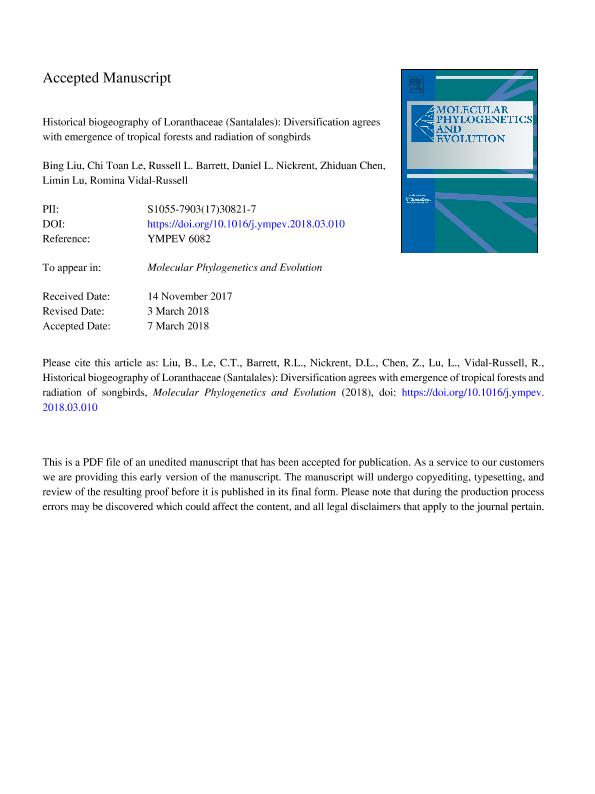Artículo
Historical biogeography of Loranthaceae (Santalales): Diversification agrees with emergence of tropical forests and radiation of songbirds
Liu, Bing; Le, Chi Toan; Barrett, Russell L.; Nickrent, Daniel L.; Chen, Zhiduan; Lu, Limin; Vidal Russell, Romina

Fecha de publicación:
07/2018
Editorial:
Academic Press Inc Elsevier Science
Revista:
Molecular Phylogenetics and Evolution
ISSN:
1055-7903
Idioma:
Inglés
Tipo de recurso:
Artículo publicado
Clasificación temática:
Resumen
Coadaptation between mistletoes and birds captured the attention of Charles Darwin over 150 years ago, stimulating considerable scientific research. Here we used Loranthaceae, a speciose and ecologically important mistletoe family, to obtain new insights into the interrelationships among its hosts and dispersers. Phylogenetic analyses of Loranthaceae were based on a dataset of nuclear and chloroplast DNA sequences. Divergence time estimation, ancestral area reconstruction, and diversification rate analyses were employed to examine historical biogeography. The crown group of Loranthaceae was estimated to originate in Australasian Gondwana during the Paleocene to early Eocene (59 Ma, 95% HPD: 53–66 Ma), and rapidly diversified, converting from root parasitic to aerial parasitic trophic mode ca. 50 Ma during the Eocene climatic optimum. Subsequently, Loranthaceae were inferred to be widespread in Australasia and South America but absent in Africa. The African and European members were derived from Asiatic lineages. The burst of diversification of Loranthaceae occurred during a climatic optimum period that coincides with the dominance of tropical forests in the world. This also corresponds to the trophic mode conversion of Loranthaceae and rapid radiation of many bird families – important agents for long-distance dispersal in the Cenozoic.
Palabras clave:
DIVERGENCE TIME
,
EOCENE
,
GONDWANA
,
LONG-DISTANCE DISPERSAL
,
MISTLETOE
Archivos asociados
Licencia
Identificadores
Colecciones
Articulos(INIBIOMA)
Articulos de INST. DE INVEST.EN BIODIVERSIDAD Y MEDIOAMBIENTE
Articulos de INST. DE INVEST.EN BIODIVERSIDAD Y MEDIOAMBIENTE
Citación
Liu, Bing; Le, Chi Toan; Barrett, Russell L.; Nickrent, Daniel L.; Chen, Zhiduan; et al.; Historical biogeography of Loranthaceae (Santalales): Diversification agrees with emergence of tropical forests and radiation of songbirds; Academic Press Inc Elsevier Science; Molecular Phylogenetics and Evolution; 124; 7-2018; 199-212
Compartir
Altmétricas



